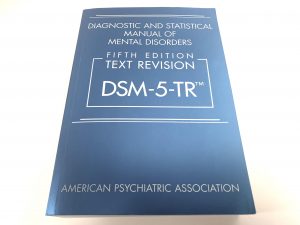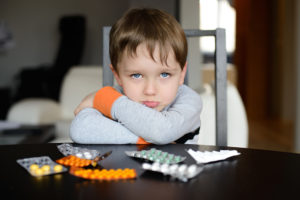CCHR says a tradition of mental health professionals diagnosing children’s belief in Santa as harmful is symptomatic of how childhood gets wrongly labeled as a psychiatric disorder, to capture part of the $90.5 billion-a-year behavioral market.
By Jan Eastgate
President CCHR International
December 2, 2022
Psychiatrists have re-defined many childhood behaviors as mental disorders, but they have also diagnosed the cherished belief in Santa Claus as harmful to children, and deemed parents who instill this to be liars and betrayers. Everything from children’s problems with reading or mathematics and poor conduct to fidgeting in class and losing toys is now coded in psychiatry’s diagnostic manual to enable the profession to bill insurance companies and thus capture part of the $90.5 billion-a-year behavioral market in the U.S.[1] Psychiatry has come under criticism for reinventing many childhood behaviors as mental diseases, but when a leading international psychiatrist, G. Brock Chisholm, first declared Santa a myth, warning parents not to encourage belief in him because of the danger to children’s mental health, there was public outrage.[2]
That outrage is still warranted but should also be directed to psychiatry’s Diagnostic and Statistical Manual of Mental Disorders (DSM) which, since it was first published in 1952, has increased the number of childhood disorders by more than 1,400%—all without scientific merit. Today, children barely out of diapers are diagnosed with mental illness, leading to a substantial increase in treatment, including prescribed psychiatric drug consumption by the very young.
Chisholm’s statement in November 1945 earned him the title of “the man who killed Santa Claus.” He stated: “Any child who believes in Santa Claus has had his ability to think permanently destroyed. Can you imagine a child of four being led to believe that a man of grown stature is able to climb down a chimney… that Santa Claus can cover the entire world in one night distributing presents to everyone! He will be a man who has ulcers at 40, develops a sore back when there is a tough job to do, and refuses to think realistically when war threatens.”[3]
Chisholm’s remarks provoked widespread criticism and a storm of media coverage, with calls for his resignation from public office as Deputy Minister of Health in Canada. The calls went unheeded and instead, he was appointed the first director-general of the World Health Organization (WHO) in 1948 and co-founded the World Federation for Mental Health (WFMH) the same year.[4]
In 1945, he also advised leading Washington, D.C. authorities, including the Deputy Director of War Mobilization and Reconversion, that the idea of “good and bad” had caused “frustration, inferiority, neurosis and inability to enjoy living”[5] He attacked teachings of right and wrong as instilling guilt, fear, and prejudice in children, that, in turn, caused war.[6]
Chisholm charged psychiatrists, whom he asserted had “escaped” from their “moral chains,” with the responsibility of freeing “the race…from its crippling burden of good and evil.”[7] Through the WFMH, Chisholm’s beliefs were executed, with one of its founding reports stating: “…[T]he family is now one of the major obstacles to improved mental health, and hence should be weakened, if possible, so as to free individuals and especially children from the coercion of family life.”[8]
More than 70 years later, Santa was still under attack within the ranks of psychiatrists and psychologists. An essay by a psychologist and mental health researcher published in the prestigious Lancet medical journal claimed that while children eventually are told the history behind Santa, they also learn “that their parents have blatantly and consistently carried on a lie for a number of years.” “The disappointment,” it was astoundingly claimed, “is so searing that it creates a ‘JFK effect’ [the assassination of President John F. Kennedy in 1963] ― people remember where they were and what they were doing when they heard the sad news. For many people, they write, the holidays never again hold the same kind of magic.” Studies suggested this had a detrimental effect on a child’s behavior.[9]
There are probably as many psychiatric and psychological theories about Santa as there are mental disorders in DSM—hundreds—but even a positive argument is still psychiatrizing childhood: “The Santa Claus tradition provides an opportunity for children to engage their imaginations, boosting the social and emotional skills that underpin resilience.”
A Psychology Today article in 2012 shockingly suggested: “The problem with Santa Claus is several-fold” but “First, it might foster the development of what later in life is called ‘magical thinking’ which is a potentially serious cognitive distortion that many therapists struggle mightily to disabuse their clients of.” The symptoms of this can lead to “a host of superstitions and irrational beliefs that are often at the core of maladies like OCD [Obsessive Compulsive Disorders] and various psychoses.”[10]
In a throwback to Chisholm’s need to destroy the concept of right and wrong, the U.S. National Alliance on Mental Illness, known best as NAMI—a group heavily funded by pharmaceutical companies which manufacture psychiatric drugs—produced a Christmas ad in 2019 using Santa to send a “mental health message.” The video starts with Santa on the roof, contemplating to the camera why the terms “naughty” or “nice” are problematic to mental health. “I think I did this all wrong,” Santa laments while conceding his advice, borne out of psychology, isn’t something that he’s “necessarily got the chops to fully understand.”
NAMI should have left the cherished Santa alone. Rather, it chose to attack this, rather than the dubious and potentially disparaging mental disorders that psychiatrists heap on children’s behavior, stigmatizing them. One of the biggest myths in psychiatry told to parents and consumers is that a “chemical imbalance in the brain causes depression” or other mental disorders.
Ironically, Tim Carey, Ph.D., once wrote an article, “What Do Santa Claus and the Chemical Imbalance Have in Common?” in which he said: “Whereas, in the Western world at least, Santa Claus is generally associated with kindness, warmth, and good tidings, the chemical imbalance narrative is mostly accompanied by misery and mayhem. Despite this troubling difference, the similarities are noteworthy.”
Many medical experts agree that “there is not one shred of evidence for the notion that an imbalance of chemicals in the brain causes mental health problems. Ironically, any imbalance in chemicals associated with mental health problems seems to occur after people have begun ingesting psychotropic medication not before…. The fallacy that mental health problems ‘are just like diabetes’ so that medication will need to be taken ‘for the rest of your life’ has beguiled health professionals and patients alike despite the emptiness of its claims.”[11]
A groundbreaking study published in Molecular Psychiatry in July this year thoroughly debunked the chemical imbalance myth, which led to millions, including children, being prescribed antidepressants. For those ages 0-18 years, the Food and Drug Administration warns the drugs may cause suicide.
Prof. Allen Frances, the former Chairman of the DSM-IV Task Force said that the manual, published in 1994, created “false epidemics” of childhood “disorders” such as Attention Deficit Hyperactivity Disorder (ADHD). He noted that 20 years after the publication of DSM-IV, the rate of ADHD in the U.S. had “tripled to a ridiculously inflated 11%. Sales of ADHD medications are approaching an obscenely profitable $10 billion a year.”[12]
According to a study in the Journal of the American Academy of Child and Adolescent Psychiatry, total spending on treatment of ADHD ranges from $143 billion to $266 billion per year, and prescription drugs for ADHD nearly tripled from $4 billion in 2007 to $11.2 billion in 2015.[13]
There is some good news: the number of American children and adolescents taking ADHD stimulants and amphetamines has declined in recent years. Sales were $9.7 billion in 2022.
Two new childhood mental disorders were added to psychiatry’s latest manual, DSM-5, in 2013: social communication disorder (SCD) and disruptive mood dysregulation disorder (DMDD), both arbitrary determinations that cannot be confirmed by any blood work, X-ray or other physical tests.[14] The diagnostic criteria for DMDD (which is restricted to children up to 12 years of age) offer no empirical data about its etiology. A 2021 study reported that in an earlier study done at a large community mental health clinic, approximately 31% of youth met the definition of DMDD.[15] With more diagnoses comes more treatment being recommended, which for DMDD includes stimulants, antidepressants, or atypical antipsychotics.[16]
Criticism of DMDD was raging even before DSM-5 was published. Slate magazine noted: “Nothing burns the critics worse than ‘Disruptive Mood Dysregulation Disorder,’” as “it is so broad and baggy that it’s ridiculous—and dangerous.” Frances said the diagnosis “will turn temper tantrums into a mental disorder.”[17]
A study published about DSM-5 in the journal Epidemiology and Psychiatric Services reported that “revised criteria illegitimately expanded psychiatric diagnosis into areas of normal-range distress and other problems in living,” including temper tantrums in childhood being “mislabeled as psychiatrically sick.”[18]
Joe Sharkey, author of Bedlam: Greed, Profiteering, and Fraud in a Mental Health System Gone Crazy said the DSM childhood disorders “ushered in a population of children with behavior problems that had never before been considered serious enough to require medical intervention, let alone hospitalization.”
In 2001, Rand Corporation had estimated that the cost of treating “troubled” children and adolescents was nearly $12 billion a year, with a quickly growing share of the bill being for psychotropic drugs.[19] Spending on mental health treatment and services overall reached $225 billion in 2019, up 52% since 2009, including prescription drugs.[20]
In 2022, more than $2 billion was allocated to hire more school psychologists, counselors, and other mental health professionals in K-12 schools.[21]
In 2021, California allocated an unprecedented $4.4 billion in one-time funds over five years to create a statewide Children and Youth Behavioral Health Initiative. Called “Master Plan for Kids’ Mental Health” it aims to greatly increase mental health services for those ages 0-25.
The title could have been lifted from a page out of the 1940s psychiatric master plan developed by Brock Chisholm and his WFMH co-founder, British psychiatrist Brigadier General John Rawling Rees.
Rees declared in his “Strategic Planning for Mental Health” in 1940: “We must aim to make it [psychiatry] permeate every educational activity in our national life: primary, secondary, university and technical education are all concerned with varying stages in the development of the child in adolescent… Public life, politics and industry should all of them be within our sphere of influence.” Further, “we have made a useful attack upon a number of professions. The two easiest of them naturally are the teaching profession and the Church; the two most difficult are law and medicine.” He continued: “If we are to infiltrate the professional and social activities of other people I think we must imitate the Totalitarians and organize some kind of fifth column activity!”[22]
Rees coined the term “psychologically controlled environment” to refer to the manipulation of a population group using mass media. Rees claimed it was possible to turn an adult population into the emotional equivalent of neurotic children, as educator Beverly Eakman documented in her best-selling book Cloning of the American Mind.[23]
Chisholm followed Rees in 1945 stating: The common denominator in “what basic psychological distortion” underpins “every civilization” and “the only psychological force capable of producing these perversions [neurotic symptoms] is morality, the concept of right and wrong, the poison long ago described and warned against as ‘the fruit of the knowledge of good and evil.’”[24]
“We have swallowed all manner of poisonous certainties fed us by our parents, our Sunday and day school teachers, our politicians, our priests, our newspapers and others with a vested interest in controlling us…. The reinterpretation and eventually eradication of the concept of right and wrong which has been the basis of child training” is the objective of “practically all effective psychotherapy.”[25]
In 1957, Chisholm addressed a WFMH conference reaffirming the strategic master plan “to recognize that neuroses propagate themselves and affect whole families” and “once the necessary one or two or three millions of [psychiatrists] are available, should be trained as salesmen and taught all the techniques of breaking down sales resistance. Should not the prospective groups of psychotherapists employ advertising and sales organization in order to drag in customers?” Further, “Should attempts be made by the profession to induce governments to institute compulsory treatment for the neuroses as for other infectious diseases?”[26]
Santa Claus—otherwise known as Saint Nicholas or Kris Kringle—dates back pre-psychiatry to the 3rd century when Saint Nicholas walked the earth and became the patron saint of children. St. Nicholas made his first inroads into American popular culture towards the end of the 18th century. Stores began to advertise Christmas shopping in 1820, and by the 1840s, newspapers were creating separate sections for holiday advertisements, which often featured images of the newly-popular Santa Claus. Salvation Army Santas have been ringing bells on the street corners of American cities since the 1890s.
Implying that such a cultural institution is a mental disorder or that children’s belief in Santa could predispose them to OCD, exemplifies what is entirely wrong with pediatric psychiatry. The psychiatric trend to redefine problems in life as mental illness is particularly pernicious when it involves children.
As sociologist Frank Furedi points out, “Since the late 1970s, there has been a creeping tendency to portray children as uniquely vulnerable to emotional damage. Before then, it was commonly believed that children could recover their strength and resilience in the aftermath of an emotionally difficult experience.”[27]
We need more of the latter, which is why CCHR’s Fight For Kids campaign is vital to reinforce that Childhood is Not a Mental Disorder—and neither is believing in Santa.

[1] “U.S. Behavioral Health Market Size to Worth Around US$ 132.4 Bn by 2027,” Precedence Research, 10 Nov. 2021, https://www.globenewswire.com/en/news-release/2021/11/10/2331828/0/en/U-S-Behavioral-Health-Market-Size-to-Worth-Around-US-132-4-Bn-by-2027.html
[2] Josephine Mazzuca, “Santa’s No Hoax: Canadians Say They Believe,” Gallup, 24 Dec. 2002, https://news.gallup.com/poll/7468/santas-hoax-canadians-say-they-believe.aspx
[3] “Brock Chisholm,” The Canadian Encyclopedia,” 30 Mar. 2022, https://www.thecanadianencyclopedia.ca/en/article/brock-chisholm
[4] Op. cit., Gallup, 24 Dec. 2002
[5] https://beststartforkids.org/failing-education/education-not-learning/
[6] Op. cit., The Canadian Encyclopedia
[7] Brock Chisholm, “The Reestablishment of Peacetime Society: The Responsibility of Psychiatry,” William Alanson White Memorial Lectures, Second Series, First Lecture, 23 Oct. 1945, Psychiatry: Journal of Biology and Pathology of Interpersonal Relations, Vol. 9, No. 1 (Feb. 1946), p. 9”
[8] “Proceedings of the International Conference on Mental Hygiene,” International Congress on Mental Health, London, 1948, ed. J.C. Flugel, D.Sc. (Columbia University Press, New York, 1949), Vol. 4, 16-21, Aug. 1949, p. 259
[9] Anna Almendrala, “Psychologists Think Your Lies About Santa Will Damage Your Kids,” Huffington Post, 1 Dec. 2016, https://www.huffpost.com/entry/psychologists-think-your-lies-about-santa-will-damage-your-kids_n_5835d898e4b01ba68ac3e3a7
[10] https://www.psychologytoday.com/us/blog/think-well/201209/is-telling-kids-santa-claus-is-real-bad-idea
[11] Tim Carey, Ph.D., “What Do Santa Claus and the Chemical Imbalance Have in Common?” MAD, 16 Oct. 2016, https://www.madinamerica.com/2016/10/santa-claus-chemical-imbalance-common/
[12] https://www.cchrint.org/2022/02/14/new-diagnostic-manual-with-adhd-listed-could-turn-childhood-into-a-mental-disorder/; Allen Frances, “Most Active Kids Don’t Have ADHD,” Psychology Today, 11 Mar. 2014, https://www.psychologytoday.com/us/blog/saving-normal/201403/most-active-kids-don-t-have-adhd; Allen Frances, “Psychiatric Fads and Overdiagnosis,” Psychology Today, 2 June 2010, https://www.psychologytoday.com/us/blog/dsm5-in-distress/201006/psychiatric-fads-and-overdiagnosis
[13] https://www.cchrint.org/2016/08/24/adhd-redefining-childhood-as-a-mental-disorder-for-profit/; “Medicines Use and Spending in the U.S.: A Review of 2016 and Outlook to 2021,” IQVia Institute for Human Data Science, 2017, https://www.iqvia.com/-/media/iqvia/pdfs/institute-reports/medicines-use-and-spending-in-the-us.pdf
[14] https://www.ncbi.nlm.nih.gov/books/NBK519712/
[15] “Psychiatric Comorbidity and Social Adjustment Difficulties in Children with Disruptive Mood Dysregulation Disorder: A National Epidemiological Study,” J Affect Disord. 2021 Feb 15; 281: 485–492. https://www.ncbi.nlm.nih.gov/pmc/articles/PMC8142276/
[16] https://www.nimh.nih.gov/health/publications/disruptive-mood-dysregulation-disorder
[17] David Dobbs, “The New Temper Tantrum Disorder,” Slate Magazine, 7 Dec. 2017, https://slate.com/human-interest/2012/12/disruptive-mood-dysregulation-disorder-in-dsm-5-criticism-of-a-new-diagnosis.html
[18] J.C. Wakefield, “DSM-5, psychiatric epidemiology and the false positives problem,” Epidemiol Psychiatr Sci., June 2015, https://www.ncbi.nlm.nih.gov/pmc/articles/PMC6998664/
[19] https://www.rand.org/pubs/research_briefs/RB4541.html
[20] https://www.cnbc.com/2021/05/10/cost-and-accessibility-of-mental-health-care-in-america.html
[21] https://www.cchrint.org/2022/10/28/cchr-launches-investigation-into-educational-decline/; U.S. Dept. of Education, “Hundreds of Millions of Dollars in Funds to Increase the Number of School-Based Mental Health Providers in Schools Provided Through the Bipartisan Safer Communities Act,” 3 Oct. 2022, https://www.ed.gov/news/press-releases/hundreds-millions-dollars-funds-increase-number-school-based-mental-health-providers-schools-provided-through-bipartisan-safer-communities-act
[22] John Rawlings Rees, M.D., “Strategic Planning for Mental Health,” Mental Health 1, no. 4 (Oct. 1940): 103-4; https://www.ncbi.nlm.nih.gov/pmc/articles/PMC5092653/pdf/menthealthlond70369-0007.pdf
[23] Beverly Eakman “Cloning of the American Mind,” Huntington House Publishers, 1998, p. 192
[24] Op. cit., Psychiatry: Journal of Biology and Pathology of Interpersonal Relations 9, no. 1 (February 1946), p. 7
[25] Ibid., p. 9
[26] Ellen McClay, Bats in the Belfry: The Case Against Mental Health, (Rosewood Publishing Company, Los Angeles, California, 1964), p. 162
[27] https://www.spiked-online.com/2017/12/13/turning-childhood-into-a-mental-illness/






SHARE YOUR STORY/COMMENT